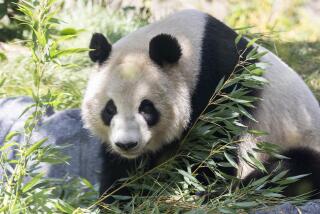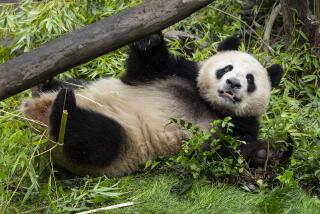6 Condors Freed to Fly in the Wild
FILLMORE — Six California condor chicks were released into the rugged backcountry of Ventura County in the Los Padres National Forest on Tuesday, joining 18-month-old Xewe as the only seven of the endangered species now in the wild.
Nine minutes after the door of the birds’ cliff-side enclosure was opened at 9:39 a.m., scientists watched with delight as 8-month-old Koyo, the oldest of the six, spread her giant wings and soared off 100-foot-high Arundell Cliff.
Koyo glided in a graceful circle in her 20-second maiden flight deep within the 53,000-acre Sespe Condor Sanctuary before coming in for a bumpy two-hop landing nearby.
“The flight was like a Michael Jordan dunk--it was so elegant it looked easy,” said an ebullient Lloyd F. Kiff, leader of the U.S. Fish & Wildlife Condor Recovery Team. “For a first-timer, she did fine on the landing as well.”
Kiff and other wildlife officials said the release of the six, which represent more than 10% of the total population in zoos as well as the wild, marked a moment of triumph in the controversial 12-year effort to bring the birds back from near extinction.
“I think we’re going to save these birds after all,” Kiff said later Tuesday at news conference in Fillmore.
“We are happy to get the condors back in the wild and back in their homes in the Los Padres National Forest,” said Maeton Freel, wildlife biologist with the forest service.
While Koyo soared, the other five displayed their nine-foot wingspans and hopped around in front of the cave-like structure, which includes a fenced and netted porch, where they have been held since they were airlifted to the site from the Los Angeles Zoo on Oct. 19.
Soon after, three more of the birds took flight, but only one ventured off the cliff.
The six chicks, four females and two males ranging in age from 6 to 8 months, were confined inside the structure Monday night while biologists dismantled the netting.
Tuesday morning, a biologist in a hidden compartment pulled open the cave door, allowing the birds to hop to freedom onto the edge of the white cliff.
“They are a feisty crew and ready to go,” said Robert Mesta, coordinator for the recovery team, a group of experts assembled from throughout the country.
“They have already started to bond, even through a fence,” he said. “And that’s a good sign.” Scientists hope the birds will breed when they come of age at 4 to 5 years.
Scientists and veterinarians examined, weighed and tagged the six last week and then installed radio transmitters on the birds’ large black wings to track the condors’ flight and eating patterns.
The birds will feed on carcasses of stillborn dairy calves that biologists provide to ensure a clean food source.
The recovery team plans to transfer more birds to the wild every year, probably moving them from the zoos in early fall and releasing them in late fall or early winter.
Next year’s release will be at the eastern edge of the San Rafael Wilderness in Santa Barbara County, which is even more remote than the rugged Sespe Condor Sanctuary, Kiff said. The site is near the Sisquoc Condor Sanctuary that was established in 1937, which Kiff said marked the beginning of the effort to save the California condor from extinction.
The plan is to continue releasing birds bred in captivity until the species is no longer considered endangered.
The Names of the Condors
The newly released condors, all given Chumash Indian names, are:
* Haku, meaning hello, a female.
* Pitahsi, meaning understanding, a female.
* Hutash, meaning Earth, a female.
* Koyo, meaning beginning, a female.
* Sqap, meaning feather bundle, a male.
* Niko, meaning water, a male.
More to Read
Sign up for Essential California
The most important California stories and recommendations in your inbox every morning.
You may occasionally receive promotional content from the Los Angeles Times.










